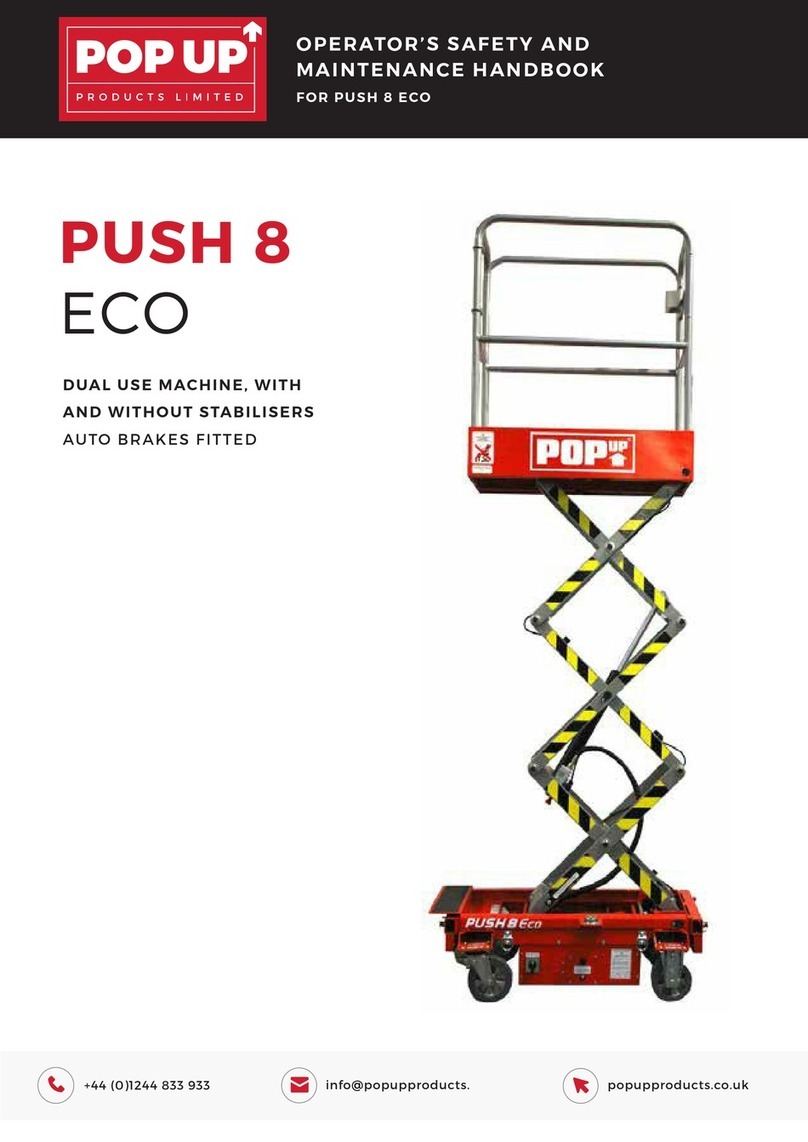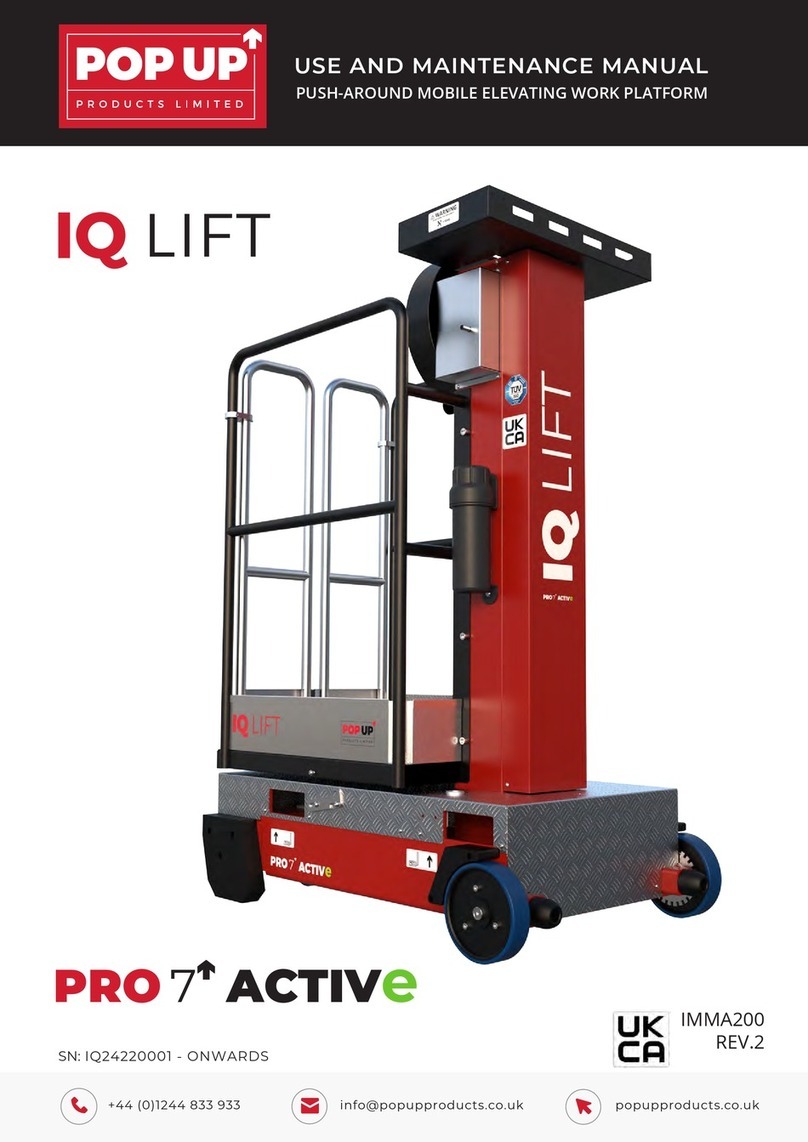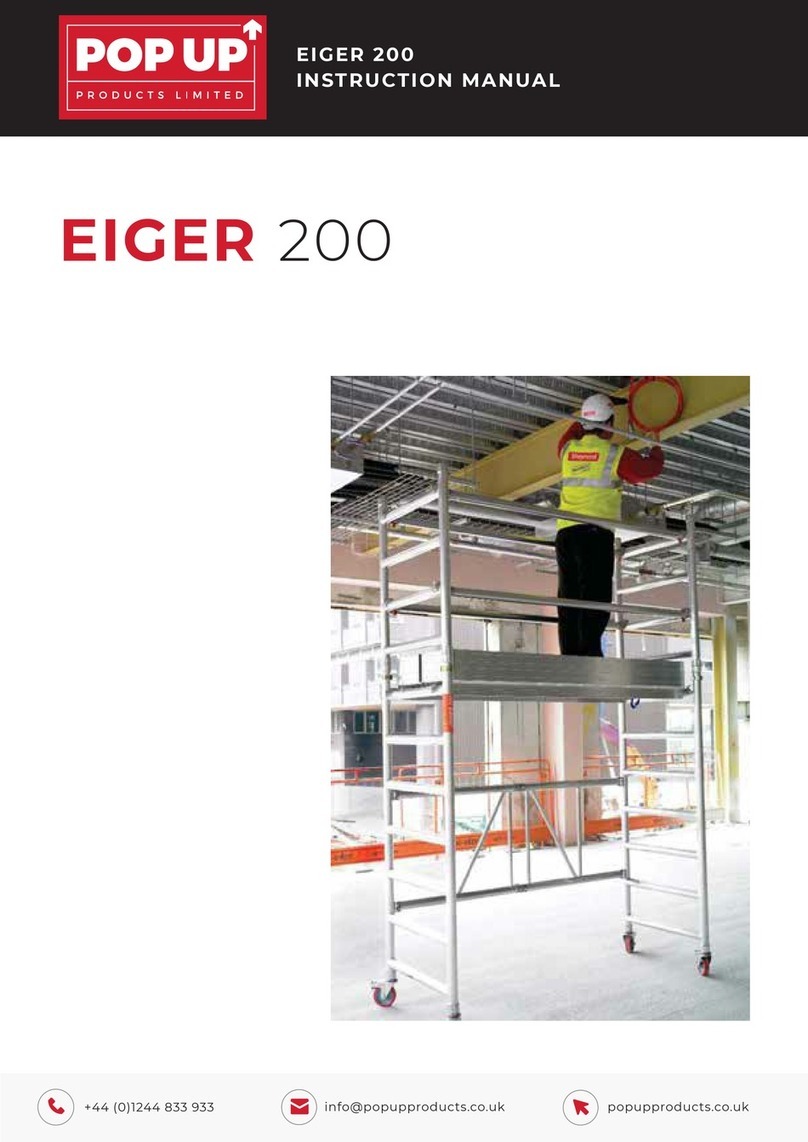
SAFETY CONT.
Only carry tools and materials with you when ascending or descending the tower if
they are safely retained in a tool belt and do not restrict your free movement. Tools
/ materials may be hoisted to the deck via a rope. PROPERLY ASSESS THE RISK
METHOD!
Do not lean from the tower and never apply undue side force. Maximum permitted
side load must not exceed 20Kg (200N). Never use boxes, steps or similar items
to gain additional height. Do not stand on the toeboards, horizontal or diagonal
braces. Always use the towers built in ladders to access platforms and climb from
inside the tower NEVER from outside. When climbing, always keep your feet in the
middle of the rungs and grip the upper rungs with your hands NEVER the sides.
When winds exceed Beaufort force 4, cease to use the tower. Always be aware that
using the tower in situations such as unclad or open ended buildings or on the
corners of buildings could cause additional wind loading of the tower structure.
Wind Speeds
Force Peak
MPH
Peak
KPH Guidance
4
6
8
18
31
46
29
50
74
Moderate breeze - raises dust and loose paper
PREPARATION
Check the ground upon which the tower is to be used is capable of supporting the
combined weight of the tower and any necessary loading. The ground should be
level and any slope should be within the scope of the adjustable legs. Ensure all
tools and equipment required to erect the tower are available and on site.
Check each component for condition and correct operation BEFORE you start
assembling the tower. Any faulty or damaged items MUST be replaced before
assembling the tower. As you inspect each part, segregate types to make the task
easier.
COMPONENTS
BRACES
oks at both ends.
The triggers, when operated, pull back to allow the hook to be placed over the
tubing used on the tower. Horizontal braces are also used as guardrails.
s) must be attached
to the top of frame horizontal tube. Always double check that each hook is
positively locked onto the tubing before using the tower.
The brace hook trigger mechanisms are colour coded to show which are horizontal
braces and which are diagonal braces. Horizontal brace triggers are coloured red
and diagonal brace triggers are coloured blue.
TYING IN
Please refer to PASMA guide ‘Tying in Mobile Towers’ available for download at
http://pasma.org.uk/shop or contact PASMA for a hard copy. tel. 0845 230 4041
DISMANTLING THE TOWER
Dismantle the tower by reversing the erection sequence. You MUST always be
protected by a full set of guardrails when standing on a platform and removing
components.
EQUIPMENT MAINTENANCE &CLEANING
Keep all components clean and free from contaminants. If any part becomes
contaminated with paint, acid, oils or similar products the tower must not be used
.
TRANSPORTATION & STORAGE
All components should be stored in a dry location where they will be protected
from adverse weather conditions. When storing or transporting, keep frames
ress damage.
INSTRUCTION LEAFLET AVAILABILITY
Keep these instructions in a safe place and ensure that they are made available to
anyone using, constructing or dismantling the tower. If these instructions become
lost or illegible, replacements should be acquired from the manufacturer.
DAMAGED COMPONENTS
Damaged components found during inspection must be quarantined until assessed
ents.
DO NOT use damaged components in the tower structure.
BALLAST
Where shown in the component list, ballast must be used to stabilise against
overturning. Only use solid materials as ballast (i.e. no loose materials) and position
to avoid overloading individual components. Ballast should be supported by the base
of the tower and securely fastened to prevent removal.
ADVANCED GUARDRAIL (AGR) PANELS
This method of construction reduces the risk of a fall from height. You will complete
an ‘assembly / access’ platform level from which is added the ‘next lift’ of frames, AGR
er is achieved.
be protected by a set
of guardrails. Attaching the AGR panels from an assembly platform level provides the
erector with a set of guardrails for the next lift of the tower. In this way the erector is
protected from a fall in advance to accessing the next assembly platform or working
platform.
EngagedDisengaged
Easy-Clip Frame Clips
The Easy-Clip frame clip’s pin locates into
aretaining hole in the frames to lock
tower sections together when placed one
on top of the other. The pin is locked in
place by a red tab to ensure that it
remains in place. From the disengaged
position, pivot the pin/tab to bring the pin
horizontal. Insert the pin fully through the
retaining hole with its tail pointing down.
Next flip the tab vertically to lock the pin
in place.Removal is simply a reversal of
the fitting sequence.
Easy-Lock Stabiliser
The Easy-Lock clamps are used to secure
the stabilisers to MiSTAIRS’s vertical
tubing. With the clamp jaw open, offer it
to the tube. Bring the jaw around the
tube and set the buckle on to the hook,
then close the black clamp arm to lock
the stabiliser in position. A similarclamp
is fitted to the stabiliser extension leg.
Wind-Lock Catch
The Wind-Lock catch is a drop down jaw
fitted to the side of the hatch platform’s
mounting hook and prevents the platform
from lifting in windy conditions. It is
attached to the horizontal tube of the
frame. To disengage, simply lift and hold
the jaw as you raise the platform clear.
ADVANCE GUARDRAIL PANELS (AGR)
The AGR panels consist of both horizontal bracing and diagonal bracing members in
a panel which can be attached to the tower from a safe guarded position.The
horizontal bracing elements within the panel also act as a set of ‘integral’ guardrails
an as such provides automatic guarding in advance to accessing the next level or lift
of tower.The panels are attached by means of the same type of triggered hook as the
horizontal and diagonal braces. The triggered hooks are found at the base of the
panel and another pair of hooks can be found at the top of the panel. However these
hooks are not triggered and are simply placed over the horizontal frame tubes. The
triggered hooks at the base are used to positively lock the panel in position. Place the
upper hooks over the horizontal frame tube 2m above the assembly platform and
then ‘snap the triggered hooks onto the lower horizontal frame tubes.
























